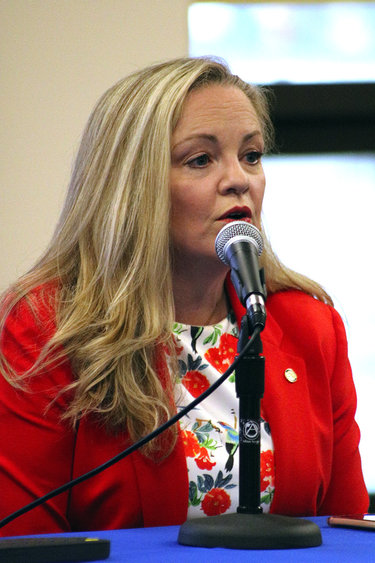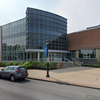Graphs and maps depict spread of COVID-19 in Albany County
The Enterprise — Michael Koff
Elizabeth Whalen, Albany County’s health commissioner, says her department has heard from area hospitals that the number of visits they are receiving for heart attacks, strokes, and other emergencies are “not what they normally are.” She said, for such emergencies, “Hospitals are still the best place for care … Please do not try to tough things out at home.” Albany County Executive Daniel McCoy said that a record number of people are “dying at home because they’re afraid to go to the hospital. He urged, “Don’t be scared to go to the hospital.”
ALBANY COUNTY — After gathering data since the first two confirmed cases of COVID-19 were announced on March 12, Albany County has created graphs, charts, and maps with information — age, race, gender, and geographic location — about those who have tested positive for the disease.
The data dashboard launched on Tuesday was created with information collected by the county’s health department; it’s posted on the county’s website.
Residents have been pushing to see the numbers, Albany County Executive Daniel McCoy said at his press briefing on Tuesday morning. “They want peace of mind because the world’s changed,” he said.
McCoy cautioned that, although “we slowed it down” with the closure of schools and businesses, “it doesn’t mean it’s gone.”
On a screen projecting the graphics from the county’s website, McCoy pointed to a bar graph that shows, by the decade, the ages of county residents who have tested positive for COVID-19. He said he hopes it speaks to “the kids out there that don’t think it’s going to happen to them.”
The second longest bar in the graph is for residents ages 20 to 29 for which there have been 119 confirmed cases in the county. The longest bar is for 50- to 59-year olds, with 154 cases.
The shortest bar is for children from 0 to 9 years old with just five cases.
Elizabeth Whalen, the county’s commissioner of health, noted that the graph on ages does not indicate the severity of the disease but rather only the ages of those who contracted COVID-19. She also said, “At all stages of life, you are vulnerable to COVID-19.”
The data is to be updated each evening so the report given by McCoy Tuesday morning was ahead of the charted numbers. McCoy reported two more deaths, both men in their eighties (see related story on Shaker Place), bringing the county’s death toll to 25. Like the vast majority of county residents who have died of COVID-19, they were elderly patients with underlying health conditions.
Albany County on Tuesday had 678 confirmed cases of COVID-19 with 754 people under mandatory quarantine and 41 under precautionary quarantine.
Thirty county residents are hospitalized with nine in intensive-care units. As of Tuesday morning, 7,135 county residents had been tested and 9.6 percent of those tested positive.
A line graph on the dashboard shows the confirmed cases climbing steadily. A bar graph shows the results from each day. There are dips for the two-week hiatus when community testing stopped due to lack of test kits from the federal government; during that period, tests were administered only to hospital patients and exposed health-care workers.
Community testing began again, on a larger scale, when the state set up a drive-through facility, with tents, on the uptown University at Albany campus. There are dips in the bar graph because of days the facility was closed due to high winds.
This past week, the county, in partnership with the Whitney M. Young Jr. Health Center, set up walk-in testing sites in high-risk neighborhoods — three in Albany and one in Watervliet.
Yet another testing site, run in partnership with the United States Department of Health and Rite Aid pharmacies, will start testing Wednesday at 1863 Central Ave. in Colonie.
“The more testing availability we have, the more valid the data is,” said Whalen. She also said that data becomes more meaningful over time.
Between 20 and 30 county residents have tested positive on most days, Whalen noted, adding, “There has not been a spike.” Nor has there been a spike in hospital admissions, she said.
A quarter of those who have tested positive for COVID-19 have been health-care workers, Whalen said.
Of residents who have tested positive, 48 percent have been males and 52 percent have been females.
White people — 47 percent or 309 cases — are by far the largest racial group to have tested positive. Black or African Americans make up 20 percent or 133 cases. Hispanics make up 7 percent or 45 cases. And Asians or Pacific Islanders also make up 7 percent, with 44 cases.
A large number of cases are classified as “other” or “unknown.” Whalen said forms to be filled out by those taking the tests became more “robust” as time when on. She also noted that the demographics may change as more results come in from the new walk-in neighborhood testing sites.
Finally, a map of the county — delineated by ZIP code rather than by town, city, or village boundaries — displays the geographic locations of residents who have tested positive for COVID-19.
The areas marked in the lightest shade of gray — which includes most of the Helderberg Hilltowns as well as the rural areas of Guilderland, bordering Schenectady County — have the fewest cases.
Berne, at 12023, and East Berne, at 12059, each have just 1 confirmed case, as do Rensselaerville, at 12147, and Medusa, at 12120.
Rural northern Guilderland, with two Schenectady ZIP codes, also has few cases: 12306 has 2 cases and 12309 has 5 cases.
Voorheesville, too, at 12186, is the lightest gray with 7 confirmed cases. And Fuera Bush, at 12067, is the lightest gray with just 1 case.
The darkest gray area in the county — ZIP code 12203 — has 81 cases. That ZIP code covers parts of the town of Guilderland and the city of Albany.
In between those two extremes are the ZIP code for Altamont, 12009, which covers not just the village but well into Knox and rural Guilderland, with a count of 14 confirmed cases, and Slingerlands, 12159, which similarly covers a large portion of rural Guilderland and New Scotland, and has 18 confirmed cases.
Delmar, too, at 12054, is a medium gray with 15 confirmed cases.
More data “may paint a different picture,” Whalen said.
The data, concluded McCoy, “helps us to make the decision when to open up … Testing’s the key.”



